Kelp Me
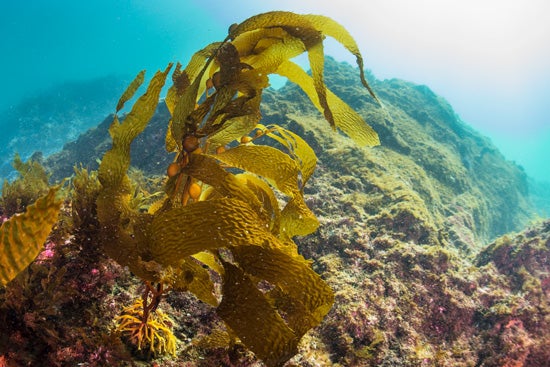
More than just the new kale, kelp is delicious, nutritious, a vital host to an immense variety of marine life on both U.S. coasts, and sustainably farmed right here in Rhode Island. Seaweed salad, anyone?
By Todd McLeish
It used to be plain old seaweed. But now it’s a “sea vegetable,” and lauded for the role it plays in marine environments. Yes, we’re talking kelp, a family of large, fast-growing algae that has been around at least five million years and thrives in shallow oceans around the world. With its solid grip on the ocean floor and the small bladders that keep its brown fronds aloft, it’s a familiar sight—or brush against the leg—for anyone who swims in Rhode Island waters.Kelp is enjoying a moment in the culinary sun as the oceanic equivalent of kale—it’s hearty, good for you, and pretty easy on the palate (ok, it might take a little getting used to). Its vast marine forests are now being actively restored because of the key role they play in important ecosystems. And in a strange twist, kelp might just save the Rhode Island fishing industry. Kelp, in fact, is many things to many people, and for two URI alumni, it’s become the focus of their work. For Rhode Island fisherman David Blaney ’03, it’s a commercial enterprise long in the dreaming; while for Tom Ford ’94, it’s at the heart of the work he directs at a California nonprofit.
Kelp is enjoying a moment in the culinary sun as the oceanic equivalent of kale—it’s hearty, good for you, and pretty easy on the palate (ok, it might take a little getting used to). Its vast marine forests are now being actively restored because of the key role they play in important ecosystems. And in a strange twist, kelp might just save the Rhode Island fishing industry.
Kelp, in fact, is many things to many people, and for two URI alumni, it’s become the focus of their work. For Rhode Island fisherman David Blaney ’03, it’s a commercial enterprise long in the dreaming; while for Tom Ford ’94, it’s at the heart of the work he directs at a California nonprofit.
The Problem with Urchin Barrens
Tom Ford ’94
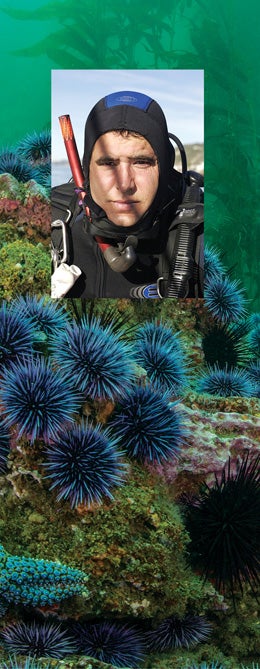 You can hear the smile and sense of wonder in Tom Ford’s voice as he describes the experience of scuba diving in a kelp forest in Southern California.
You can hear the smile and sense of wonder in Tom Ford’s voice as he describes the experience of scuba diving in a kelp forest in Southern California.
He paints a picture of being on a boat on a quiet sunny day, the water sparkling and clear as the tops of butterscotch-colored kelp fronds undulate at the surface. And then he drops over the side into 50 feet of water.
“It’s like shafts of golden light shooting down to the ocean floor, like flying through a cathedral comprised of algae and thousands of fish, like stained glass windows of extraordinary color,” he said. “It’s an unbelievably gorgeous and wildly dynamic environment, and it’s unlike any other experience I’ve ever had.”
That experience goes a long way toward explaining Ford’s complete devotion to protecting the region’s forests of giant kelp, which can grow more than 100 feet tall from the seafloor to the water’s surface and host an immense variety of marine life, from starfish and anemones to octopus, rockfish and sea otters. It’s the reason he became the executive director of the Bay Foundation, which works to protect the water quality and marine life in Santa Monica Bay by conducting research, engaging in restoration projects, and investing in infrastructure to reduce pollution.
“We work from the mountains to the beaches and into the ocean itself,” he said. “So on any given day, I’m looking at a project to remove bridges that no longer allow fish to migrate upstream, working with kids on educational programs, exploring wetlands to find ways to protect them, or using oceanographic equipment to monitor marine protected areas. It’s terrifically enriching, and there’s no shortage of work to be done.”
But his work begins and ends with kelp.
According to Ford, California’s kelp forests began to decline in the mid-1800s, when sea otters were hunted to near extinction. Without the otters to prey upon the abundant sea urchins, the urchins consumed the entire kelp forest, forcing the rest of the marine life that lived there to move elsewhere or die.
“Once that happened, we entered an alternative stable state ecosystem where urchins can remain in this barren community supporting little of anything but themselves,” he explained, noting that since the urchins are undernourished, fishermen cannot harvest and sell them. “And it can persist for decades. If we don’t actively manage it, the urchin barrens will stay that way. But if we reduce the density of urchins, we can get the kelp forest to return.”
With sea otters still absent from the area, Ford is using a strategy for reducing urchin numbers that isn’t found in most conservation manuals. But it works: After mapping the urchin barrens and monitoring the density of urchins, he arms teams of fishermen and volunteers with hammers. They smash the urchins, more than 3.3 million to date.
“In the past two and a half years, we have spent nearly 7,000 hours underwater and have cleared 34 acres of the ocean floor from overly-dense urchins, from 70 urchins per square meter down to the preferred density of 2,” he says proudly. “That area wasn’t just a little messed up, it was way messed up.”
His target is to dramatically reduce urchin numbers in a 150-acre area of the bay, which will allow the kelp forests to return on their own. Ford’s early success in this effort has found him in demand in Canada, Japan, Norway, Australia and Greece, among other locations where sea urchins have wiped out kelp, put fishermen out of work and raised concerns about food security.
“We’re working up a focused fix with intensive scientific monitoring to prove this case for other countries and other industries,” he says.
Ford’s enthusiasm for kelp emerged in midcareer, but it spawned from his childhood love of the water and his URI marine biology coursework.
“I grew up in Pennsylvania, landlocked in cattle and corn. But I was an avid swimmer and Jacques Cousteau brought the ocean into my living room and I was sold,” he said. “I was a marine biologist long before I even saw the ocean.”
It was Professor Frank Heppner—who taught ornithology, not marine biology—who especially challenged Ford’s thinking and became his mentor. “He was switched on and taught me how to commit to the discipline,” Ford says.
After graduation, he worked as a quahogger, baited lobster pots for Point Judith fishermen, and assisted with sea turtle research before landing a job at the Norwalk Maritime Aquarium, where he was responsible for collecting fish and other marine life from Long Island Sound to exhibit.
He eventually yearned to explore another ocean, so he moved to California to collect marine life to exhibit at the aquarium on Santa Monica Pier.
“I started scuba diving to see the environment and to collect the animals that I needed,” Ford said. “And that’s where I met my first kelp forest.”
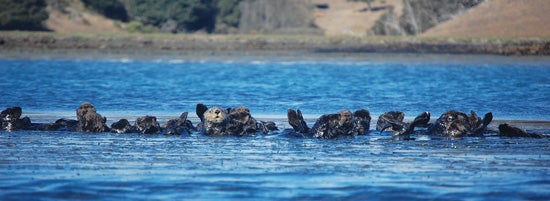
Why You’ll Eat Sea Vegetables
David Blaney ’03
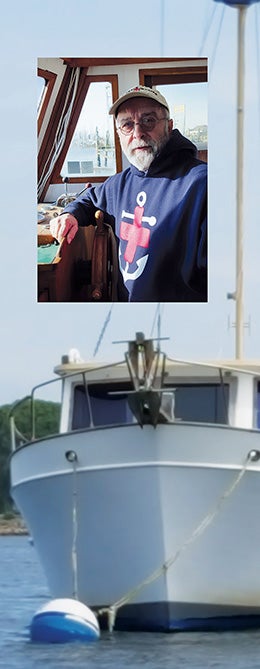 David Blaney’s introduction to kelp, like Ford’s, came later in his career. He comes from a commercial fishing family, one that has fished Rhode Island waters for more than 300 years.
David Blaney’s introduction to kelp, like Ford’s, came later in his career. He comes from a commercial fishing family, one that has fished Rhode Island waters for more than 300 years.
He worked as a lobsterman, trawled for cod, captured tuna and swordfish on longlines, and dug for shellfish, among other maritime pursuits. He even started a consulting business to advise commercial fishermen on boat safety.
At age 50, Blaney decided to enroll at URI to earn an engineering degree. “As fish stocks continued to dwindle and commercial fishing got tougher, I decided to go back to college,” he said. “I had gone for a couple semesters back when all I wanted to do was go to sea. It opened my eyes to a broader world, so I always wanted to go back. And ocean engineering seemed like the natural way to go.”
During his time at the Narragansett Bay Campus, he found himself working in a marine algae lab with Professor Scott Nixon and Marine Scientist Steve Granger studying eelgrass restoration.
“Steve picked up a handful of eelgrass and said you could eat it raw, and so I tried it,” Blaney says. “That got me interested in seaweed, and it’s been percolating ever since.”
Now at age 67, after figuring that it had percolated long enough, he started Point Judith Kelp, a company based on his 38-foot fishing trawler, whose mission is to grow and harvest fresh sea vegetables. He started out collecting wild seaweeds like sea lettuce, Irish moss and sugar kelp near the Galilee jetty, cutting it off the rocks by hand but leaving enough of the plant attached so it would regrow. Now he’s trying his hand at kelp farming.
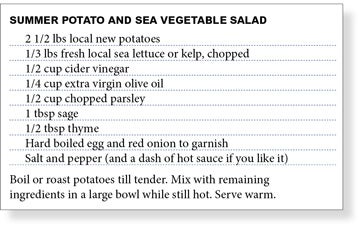 According to Blaney, kelp has been cultivated in Asia for thousands of years. So after investigating the shellfish aquaculture industry in Rhode Island and thinking it too crowded, he began looking for locations that would be suitable for farming kelp. He expects to have a permit for a farm in the Harbor of Refuge in Galilee later this year.
According to Blaney, kelp has been cultivated in Asia for thousands of years. So after investigating the shellfish aquaculture industry in Rhode Island and thinking it too crowded, he began looking for locations that would be suitable for farming kelp. He expects to have a permit for a farm in the Harbor of Refuge in Galilee later this year.
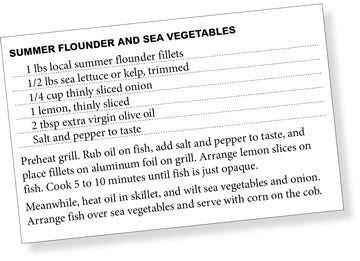 “Rhode Island is a huge foodie state, so almost everybody is a potential customer,” he says. “I primarily sell to consumers now, though I have some big commercial accounts outside the state. And if my farm is successful, I’ll produce such a volume that I’ll need to sell wholesale, too.”
“Rhode Island is a huge foodie state, so almost everybody is a potential customer,” he says. “I primarily sell to consumers now, though I have some big commercial accounts outside the state. And if my farm is successful, I’ll produce such a volume that I’ll need to sell wholesale, too.”
Blaney says farmed sugar kelp, a species native to Rhode Island, starts out as spores grown on spools of string in an aquarium. The string is then tethered to weights and buoys and dropped into water at least 20 feet deep, where the kelp will grow about 8 feet long between October and May, when it is harvested.
“Kelp has a flavor the Japanese call umami—a salty and sour taste on your tongue,” Blaney said. “My favorite time to eat it is when it first comes out of the water.”
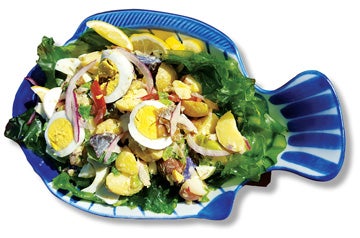
He recommends using kelp as part of a seaweed salad or as a stock for soups or other dishes. It’s highly nutritious and contains no fat, and it has many environmental benefits as well, since it absorbs nitrogen and carbon and requires no fertilizer or fresh water. Blaney also makes a syrupy plant food by soaking kelp in hot water to release its nutrients. And he’s working on animal feed applications as well.
While he prefers to sell his seaweeds fresh—they sold out the first day he brought them to a local farmer’s market—he is also experimenting with a frozen product.
“Most seaweed in the tidal zone freezes and thaws in the winter with the ebb and flow,” he explained. “That’s what their cellular structure is designed for. When the tide goes out in winter, they freeze, then thaw when it comes back in.”
So why is he undertaking such a major venture at an age when most people are retiring? To provide the next generation of fishermen with an alternative industry that will keep them working on the water.
“I’m trying to develop a new industry for fishermen to expand into,” Blaney says. “They drag seaweed up in their nets, and I tell them to save it and I’ll buy it from them. But they can’t quite get their heads around it. They don’t quite get it yet.
“I’m not going to get rich at growing kelp in my lifetime,” he adds. “But I’m hoping these new guys can expand into it, because everything else they’re catching is disappearing.” •
 Home
Home Browse
Browse Close
Close Events
Events Maps
Maps Email
Email Brightspace
Brightspace eCampus
eCampus


